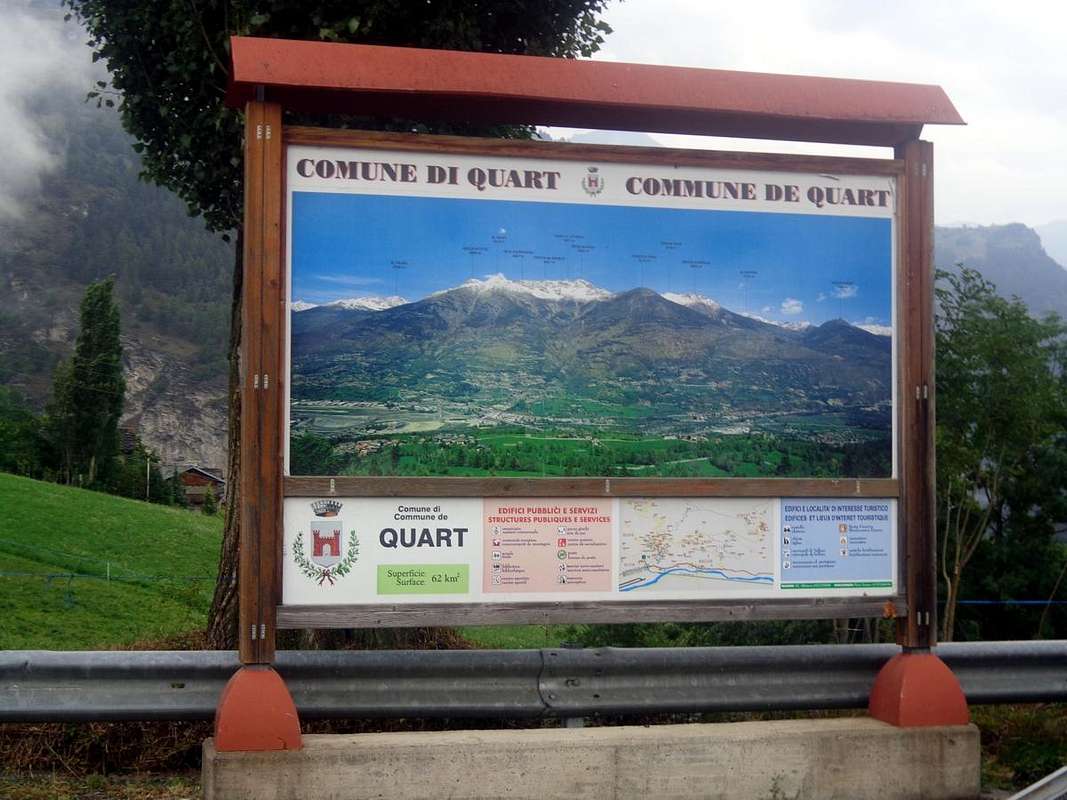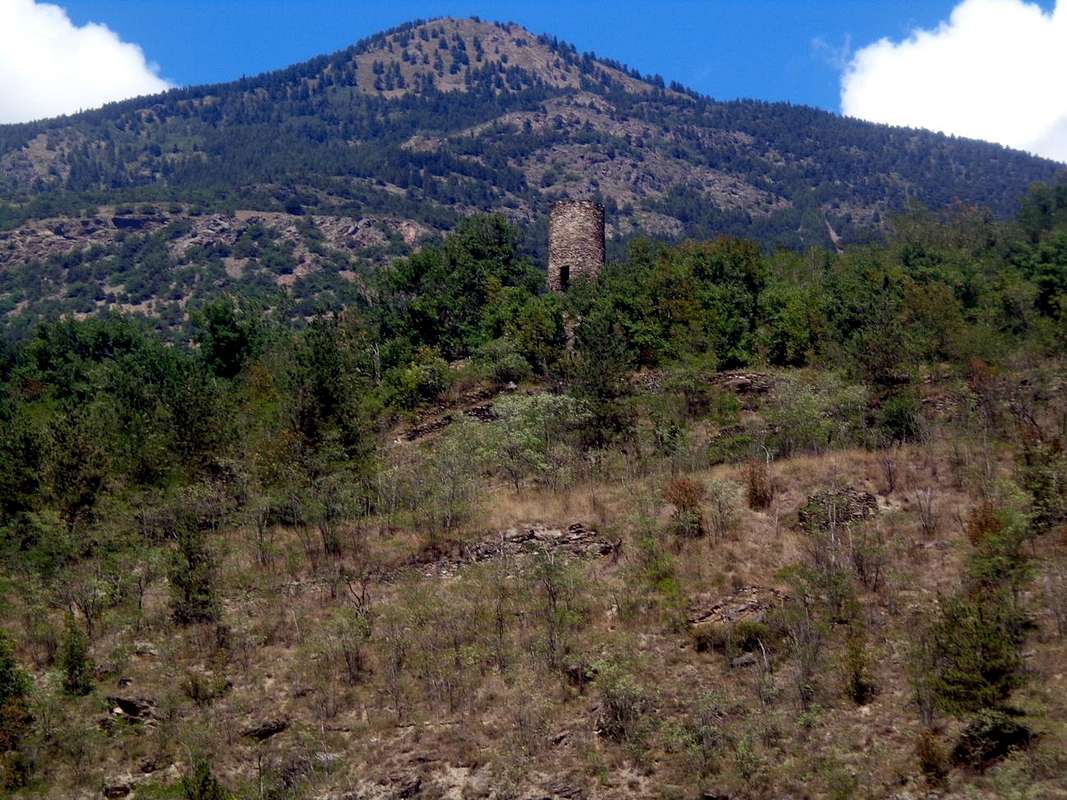-
 993 Hits
993 Hits
-
 80.49% Score
80.49% Score
-
 12 Votes
12 Votes
|
|
Custom Object |
|---|---|
|
|
45.74090°N / 7.43025°E |
|
|
Earth PYRAMIDS & CALANQUES in Aosta Valley (Chétoz - La Plantaz) / 3 |
|
|
Aosta Valley |
GREAT WALL / GRANDE MURAGLIA OVERVIEW
Also the Valley of Aosta has its glacial erosion pyramids, among which I want to illustrate those relating to three specific locations: 1) - The erosion pyramids in the valley above the small Town of Saint Pierre; 2) - The pyramids in the highest part of the Gorgia del Dard, which Abbot Joseph Maria Henry baptized in 1800 as the "Devil's Wall"; 3) - The pyramids or rather the steep wall looming over the Regional Road in the stretch that, after that of Chambave (496 meters and 19 kilometers from Aosta), connects the Municipalities of Nus (ad Nonum Praetoriae, 535 meters and 12 Kilometers from Aosta) and Quart (ad Quartum Praetoriae, 535 meters and 12 Kilometers from Aosta), both immediately at the eastern gates of the City of Aosta (583 meters, the ancient Augusta Praetoria Salassorum of 25 BC), between the two towns of La Planta (or Plantaz) (540 meters) and the small village with Chétoz tower (621 meters), just below on a promontory overlooking the Quart bridge over the Dora Baltea River.
Starting from Aosta and immediately after Villefranche of Quart (557m), the Regional Road n ° 26 towards Ivrea and Turin on its route alongside the Dora Baltea River, as well as parallel to the A1 motorway, meets a road roundabout; from this a secondary deviation to the left (Northwest) goes back to the above the small Village of Chétoz (557m; rounded and stone tower on a small stony-grassy promontory) and then head further West towards various villages below the triple Hamlet of Trois Villes (Porsan in bottom, Avisod in middle and Fonteil more in high at the end). Continuing on the valley floor, however, you immediately find a semi flat place on the left just before the Hamlet of La Plantaz (540 m) now into the Nus Municipality (not to be confused with the other La Plantaz Hamlets of the Municipalities of Quart and Chambave). Above this stretch and towards the North there is the whole area of interest to us; that is, a series of badlands that constitute a fairly linear and continuous wall. They form the terminal part of a very very ancient glacier which descending from the Croix de Fana (2211/13m) and from the adjacent to the East Comba Dèche (between the first and Becca d'Aveille or of Avuille, 2623 meters further East) went to flow into the River Dora Baltea or, better, inside the great Balteo Glacier which from Courmayeur descended for over 100 Kilometers reaching the gates of Ivrea City. Of all this transforming and carrying movement, this fairly large base area only remains, which highlights the movement and flow of glacier down to the bottom of the central valley of Dora Baltea ; mincing and gluing everything he encountered ...
Pano on Regional Route between Quart/Nus Municipalities by Osw 2015
Anche la Valle d'Aosta possiede le sue piramidi di erosione glaciale, tra le quali voglio illustrarvi quelle concernenti tre specifihe località: 1)- Le piramidi di erosione nel vallone soprastante il Comune di Saint Pierre; 2)- Le piramidi nella parte più elevata della Gorgia del Dard, che l'Abate Joseph Maria Henry battezzò nel 1800 come il "Muro del Diavolo"; 3)- Le piramidi o meglio il ripido muraglione incombente sulla Strada Regionale nel tratto che, dopo quello di Chambave (496 metri e 19 kilometri da Aosta), unisce i Comuni di Nus (ad Nonum Praetoriae, 535 metri e 12 Kilometri da Aosta), e Quart (ad Quartum Praetoriae, 548 metri e 7 kilometri da Aosta), entrambi subito alle porte Orientali della Città di Aosta (583 metri nonché l'antica Augusta Praetoria Salassorum del 25 avanti Cristo), tra le due località di La Planta (oppure La Plantaz) (540 metri) ed il piccolo Villaggio con torre in pietra di Chétoz (621 metri), subito al di sotto su di un promontorio che si affaccia sul ponte di Quart sopra la Dora Baltea.
Partendo da Aosta e subito dopo Villefranche di Quart (557 m), la Strada Regionale n° 26 verso Ivrea e Torino nel suo percorso affianco della Dora Baltea, nonché parallelo all'Autostrada A1, incontra una rotonda stradale; da questa una deviazione secondaria verso sinistra (Nordovest) risale al soprastante Villaggetto di Chétoz (557 m; torre arrotondata ed in pietra su di un piccolo promontorio erboso-sassoso) per poi dirigersi più ad Ovest verso vari villaggi sottostante la triplice Frazione di Trois Villes (Porsan dabbasso, Avisod in mezzo e Fonteil più in alto al termine della strada asfaltata). Continuando invece sul fondo valle immediatamente si incontra un piazzale semipianeggiante sulla sinistra (Nord) precedente di poco la Frazione di La Plantaz (540 m), ormai all'interno del Comune di Nus (da non confondere con le altre frazioni La Plantaz dei Comuni di Quart e Chambave). Al di sopra di questo tratto e verso Settentrione si dispiega tutta la zona a noi di interesse; cioé una serie di calanchi che costituiscono una muraglia abbastanza lineare e continua. Formano la parte terminale di un antichissimo ghiacciaio che scendendo dalla Croix de Fana (2211/13 m) e dall'adiacente ad Oriente Comba Dèche (tra la prima e la Becca d'Aveille oppure d'Avuille , 2623 metri ancora più ad Est) andava a confluire nella Dora Baltea o, meglio, dentro il grande Ghiacciaio Balteo che da Courmayeur scendeva per oltre 100 Kilometri raggiungendo le porte della Città di Ivrea. Di tutto ciò rimane questa abbastanza ampia area basale, che evidenzia il movimento e lo scorrere verso il basso del ghiacciaio; tritando ed incollando tutto quello che incontrava ...
Chétoz 's Tower near La Plantaz Hamlet on Regional Road, by Osw 2015
3)- In questa terza ed ultima disamina vediamo di trattare le piramidi o, e meglio, il ripido muraglione incombente sulla Strada Regionale nel tratto che unisce i Comuni di Nus (ad Nonum Praetoriae) e Quart (ad Quartum Praetoriae), entrambi subito alle porte Orientali della Città di Aosta (l'antica Augusta Praetoria Salassorum, cioé del popolo Salasso nonché fondata dai pretoriani in onore di Caio Cesare Augusto Ottaviano nel 25 avanti Cristo), tra le due località di La Planta (oppure La Plantaz, 540 metri) ed il piccolo Villaggio di Chétoz con la sua torre in ruvida pietra (621 metri). Due località sul fondo valle nonché ai piedi di quel versante Sudorientale che scende sopra il triplice Villaggio di Trois Villes (Fonteil 1423 metri, Avisod 1398 metri e Porsan 1299 metri), a loro volta soprastanti in media collina quello di Vignil (946 metri; famoso per la sua Area Neolitica con relative sepolture) nonché, giù in fondo ed oramai presso la Dora Baltea, quelli di Chétoz ed appena più ad Est di La Plantaz. Una parete scoscesa di sassi intrappolati in un atavico terriccio variante dal grigiastro al marron ed ad un color giallastro o giallognolo, donante l'impressione di crollar al di sotto da un momento all'altro. Incollato da uno sputo, ormai evaporato. Tanto che, passandovi al di sotto, trattieni il fiato per la preoccupazione d'un crollo immediato. Lo ricorda un macigno che, precipitato alla base, é stato pittorescamente dipinto di blù, forse per ricordarvi del pericolo ...
Croix de Fana (2213m) just above Chétoz/La Plantaz , by emilius 2002
Riassumendone la descrizione, possiamo dividere, arbitrariamente e quindi da un punto di vista prettamente personale, la zona (nella quale oggigiorno si stanno effettuando dei lavori di messa in sicurezza alla base dell'intero pendio calanchivo) in quattrro parti specifiche; quindi iniziando l'analisi da sinistra o Sudovest e verso destra o Sudest riscontriamo differenziando i settori, che in realtà costituiscono un tutt'uno:
a)- Una prima area, a ridosso della strada che inizia a salire verso la Frazione di Chétoz, formata da una più grande piramide e prevalentemente rocciosa verso Meridione, mentre sul lato Orientale risulta formata da una colata petrosa scannellata da tre piccole costole calanchive, la prima di sinistra delle quali risulta appena accennata, mentre le altre due s'evidenziano come sottili crestine sinuose color bianco-grigiastro.
b)- Dopo questa piramidina troviamo una selletta sovrastata da alberi che viene seguita, procedendo circolarmente, da una muraglia verticale dal colore variante dal grigiastro al giallognolo e con venature che danno anche sul rossiccio; poi di colpo la medesima assume un colore marron, formando anche un caratteristico tetto semicircolare verso il basso, tale da dare l'effetto di un imminente pericolo.
c)- Al di là di questo settore, nonché al di sopra, troviamo un grande muro, al sommo della cui incisione netta troviamo una fila di alberi quasi sospesi; il medesimo si allunga verso Levante denotando una serie di caratteristiche striature orizzontali e di colore grigio nel quale sono incastonate una serie di pietre, ben visibili dal basso. Mentre al di sotto troviamo una serie di cinque piccole piramidi accollate l'una all'altra nonché di colore quasi biancastro, tali da testimoniare molto probabilmente di una pressione, da parte dello scorrimento del ghiacciaio, ancora maggiore con stritolamento in polveri molto sottili.
d)- Da questo punto la parete, assumendo quindi una forma ad arco ovvero concava, perdendo in altezza e consistenza digrada verso Sudest nonchè assumendo un colore con sfumature rossicce.
e)- Oltrepassata questa area e proseguendo invece con la strada verso la Frazione di Chétoz, troviamo, ad uno dei tornanti subito successivi, un'altra breve zona che evidenzia il lato opposto dell'erosione glaciale. Da qui in avanti, mentre la strada procede maggiormente verso Occidente, raggiungendo le Frazioni di Seran (709 m) con la vicina Les Cleyves (709 m), Epillod (792 m), Massuc (723 m), Chantignan (748 m), Valgillianaz (709 m), Argnod (829 metri, deviazione per Vignil e l' Area Neolitica di Vollein), Eclou (851 m) e Porsod (1063 m), non si riscontrano più fenomeni d'erosione glaciale particolarmente in vista.
f)- Altre peculiarietà di questa zona delle Alpi Pennine, nella zona centrale della medesima ovvero verso la Dora Baltea, possiamo inoltre riscontrare un particolare tipo di erosione rocciosa nei pressi della località di Vignil (946 metri, antiche sepolture Neolitiche subito ad Oriente in località del Villaggio di Vollein, 891 metri e subito al di sopra di Chétoz/La Plantaz. Vedi articoli specifici in SP), dov'alte pareti rocciose color giallo (palestra di roccia) testimoniano d'un ostacolo "da rodere" più resistente incontrato dal ghiacciaio; tale almeno da deviarlo maggiormente a sinistra, cioé sulla sua destra idrografica ed orografica.
g)- Buon ultima l'osservazione dell'erosione nella parte più alta, ovvvero nei pressi dei tre villaggi di Trois Villes (Porsod, Davisod, Fonteil), dove alle pendici della Cresta Sudest della Croix de Fana riscontriamo i sintomi di un primo sgretolamento delle rocce, molte delle quali poi trasportate come massi erratici contro un area formata da altre molto più resistenti; al di là dei prati della Frazione di Davisod e presso quella minuscola "riserva storica", dedicata al Monumento del Partigiano/Monument aux Maquisards (1364 metri), anche con targhe che ricordano le fucilazioni nazi-fasciste (Anche qui vedi articoli specifici in SP).




